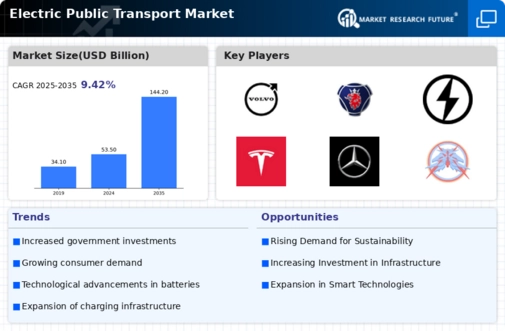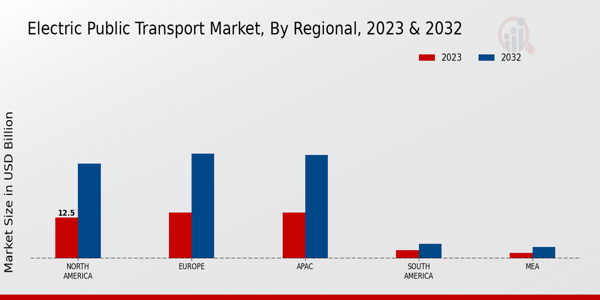Market Growth Projections
The Global Electric Public Transport Market Industry is poised for substantial growth, with projections indicating a market size of 144.2 USD Billion by 2035. This anticipated growth is underpinned by various factors, including government support, technological innovations, and increasing environmental awareness. The market is currently valued at 53.5 USD Billion in 2024, reflecting a robust foundation for future expansion. The compound annual growth rate of 9.42% from 2025 to 2035 suggests a dynamic and evolving landscape, where electric public transport solutions are likely to become increasingly prevalent in urban settings.
Technological Advancements
Technological advancements are transforming the Global Electric Public Transport Market Industry, leading to enhanced efficiency and performance. Innovations in battery technology, such as solid-state batteries, are increasing the range and reducing charging times for electric buses. Furthermore, the integration of smart technologies, including real-time tracking and automated systems, is improving operational efficiency. These advancements not only enhance user experience but also contribute to cost reductions in the long run. As a result, the industry is expected to grow at a compound annual growth rate of 9.42% from 2025 to 2035, reflecting the significant impact of technology on market dynamics.
Urbanization and Population Growth
Urbanization and population growth are significant factors influencing the Global Electric Public Transport Market Industry. As more people migrate to urban areas, the demand for efficient and sustainable public transport systems intensifies. Cities are investing in electric public transport to accommodate growing populations while addressing congestion and pollution challenges. This trend is particularly evident in developing regions, where rapid urbanization necessitates innovative transport solutions. The market's expansion is expected to be robust, with projections indicating a substantial increase in electric public transport adoption as urban centers prioritize sustainable infrastructure.
Economic Viability and Cost Savings
The economic viability of electric public transport is becoming increasingly apparent within the Global Electric Public Transport Market Industry. Electric buses and trams typically have lower operational costs compared to their diesel counterparts, primarily due to reduced fuel expenses and maintenance costs. As cities evaluate their transport budgets, the long-term savings associated with electric vehicles are compelling. This financial incentive is encouraging more municipalities to transition to electric fleets. The growing recognition of these cost benefits is likely to drive market growth, as stakeholders seek to optimize their public transport expenditures.
Government Initiatives and Policies
Government initiatives and policies play a pivotal role in the Global Electric Public Transport Market Industry. Many countries are implementing stringent regulations aimed at reducing carbon emissions and promoting sustainable transport solutions. For instance, the European Union has set ambitious targets for electric vehicle adoption, which directly influences public transport systems. In 2024, the market is valued at approximately 53.5 USD Billion, driven by these supportive policies. As governments allocate funding for electric buses and charging infrastructure, the industry is likely to experience accelerated growth, with projections indicating a market size of 144.2 USD Billion by 2035.
Environmental Concerns and Sustainability
Growing environmental concerns are driving the Global Electric Public Transport Market Industry towards more sustainable solutions. Urban areas are increasingly facing air quality issues, prompting cities to adopt electric public transport options to mitigate pollution. The shift towards electric buses and trams is seen as a viable solution to reduce greenhouse gas emissions. This trend aligns with global sustainability goals, as cities aim to create cleaner and healthier environments for their residents. The increasing awareness of climate change impacts is likely to further propel the market, as stakeholders recognize the importance of sustainable transport in urban planning.















